继承与多态
参考:
- https://juejin.cn/post/6857057314504081416
- https://www.zhihu.com/question/389546003/answer/1194780618
- https://www.zhihu.com/question/29251261/answer/1297439131
- https://stackoverflow.com/questions/18035293/what-is-early-static-and-late-dynamic-binding-in-c
实验环境:os: centos8.5 / kernel: 4.18.0 / gcc: 8.5.0 / arch: x86-64
1. 概述
多态(polymorphism)是 c++ 支持的 3 大特性之一,通过继承关系,一套虚函数接口(基类)可以拥有许多不同的实现(派生类)
2. 对象内存模型
注意这里展示的是对象的内存模型,一个实例化对象拥有的资源是类中的非静态成员变量,类中的成员函数是所有对象共有的,不属于某个对象,静态成员是整个程序共有的,也不属于某个对象。同样,虚函数表也是所有对象共有的。
2.1 无虚函数的单一继承
如下函数:
class Base {
public:
~Base() {}
void interface() {}
public:
int b;
};
class Derived : public Base {
public:
~Derived() {}
void interface() {}
public:
int d;
};
int main() {
Derived d;
return 0;
}
使用 clang -Xclang -fdump-record-layouts test.cpp 指令导出对象内存结构如下:
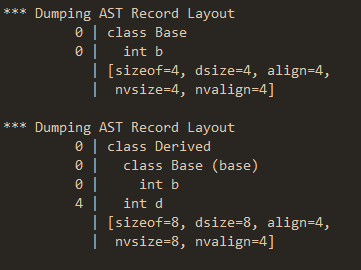
可见,Derived 类通过继承 Base 类,Base 类中被继承的成员变量出现在了 Derived 类的开头(offset 为 0),Derived 类的 int d 成员变量被排在了 Base 类后面,offset 为 sizeof(int b)。
在 Derived 类对象中,我们可以称继承而来的 Base 类成员变量为 subobject。
需要关注的一点是,即使 Base 类的 int b 成员是一个 private 的,Derived 类也能继承下来,但是没有访问权限。
2.2 无虚函数的多重继承
如下函数:
class Base01 {
public:
~Base01() {}
void interface() {}
public:
int b01;
};
class Base02 {
public:
~Base02() {}
void interface() {}
public:
int b02;
};
class Derived : public Base01, public Base02 {
public:
~Derived() {}
void interface() {}
public:
int d;
};
int main() {
Derived d;
return 0;
}
使用 clang -Xclang -fdump-record-layouts test.cpp 指令导出对象内存结构如下:
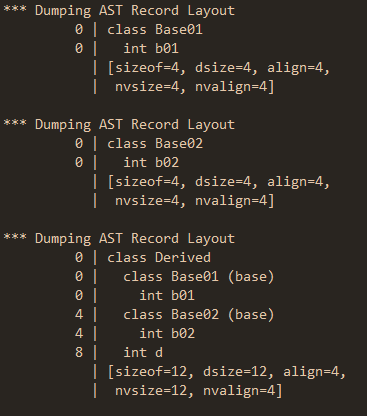
可见,在 Derived 类对象中,第一个继承的 Base01 类成员排在了 offset=0 的位置,第二个继承的 Base02 类成员排在了 Base01 后面, offset 为 sizeof(int b01),Derived 类的 int d 成员变量被排在了两个基类后面,offset 为 sizeof(int b01)+sizeof(int b02)。
即多重继承类似单一继承,多个 subobject 紧挨着从派生类的起始地址开始放置。
2.3 有虚函数的单一继承
如下函数:
class Base {
public:
virtual ~Base() {}
virtual void interface() {}
public:
int b;
};
class Derived : public Base {
public:
~Derived() {}
void interface() override {}
public:
int d;
};
int main() {
Derived d;
return 0;
}
使用 clang -Xclang -fdump-record-layouts test.cpp 指令导出对象内存结构如下:
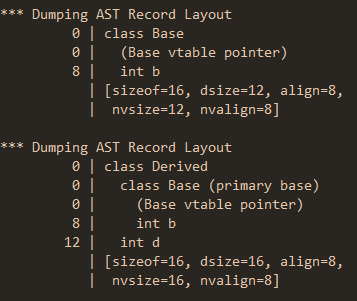
可见,在基类和派生类对象中,int b 的 offset 从 0 变为了 8,这 8 个字节被 Base vtable pointer 指针占据。这既是虚函数表指针,基类和派生类各一个,分别指向不同的虚函数表。
2.4 有虚函数的多重继承
如下函数:
class Base01 {
public:
virtual ~Base01() {}
virtual void interface() {}
public:
int b01;
};
class Base02 {
public:
virtual ~Base02() {}
virtual void interface() {}
public:
int b02;
};
class Derived : public Base01, public Base02 {
public:
~Derived() {}
void interface() override {}
public:
int d;
};
int main() {
Derived d;
return 0;
}
使用 clang -Xclang -fdump-record-layouts test.cpp 指令导出对象内存结构如下:
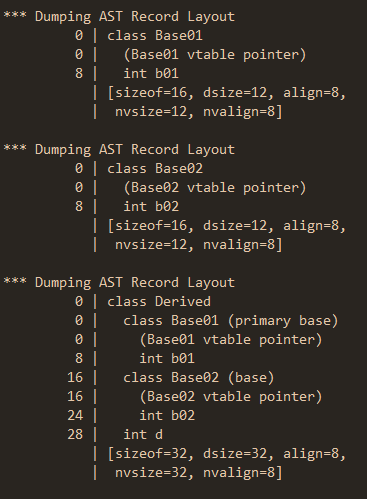
可见,因为 Derived 类继承的两个基类都有虚函数,所以 Derived 类拥有两个虚函数表指针。
3. 虚函数表结构
- 一个可执行程序的生成分为预处理、编译、汇编、连接 4 个阶段,虚函数表在编译阶段生成,一般存储在只读数据段(.rodata)中。
- 在单一继承中,每个类对应一个虚函数表(含虚函数的继承),每个实例化的对象拥有一个由编译器安插的虚函数表指针,即类的不同实例化对象的虚函数表指针指向同一个虚函数表。
- 在多重继承中,无论有多少个含虚函数的基类,每个类也只对应一个虚函数表。但是,在实例化对象中,编译器会安插多个虚函数表指针,指针指向表的不同位置。
在前面讨论的类对象内存模型中,是没有虚函数表的,因为虚函数表不属于某个对象,本节主要来看看虚函数表的结构。
3.1 单一继承下的虚函数表
如下函数:
#include <stdio.h>
class Base {
public:
virtual ~Base() {}
virtual void interface() {
printf("base interface called\n");
}
public:
int b;
};
class Derived : public Base {
public:
~Derived() {}
void interface() override {
printf("derived interface called\n");
}
public:
int d;
};
typedef void(*func)();
int main() {
Derived obj;
long long* vptr = (long long*)(*(long long*)&obj);
printf("vptr: %lx\n", vptr);
func f = (func)*(vptr+2);
f();
return 0;
}
使用 g++ -fdump-lang-class test.cpp 指令导出虚函数表内存结构如下:
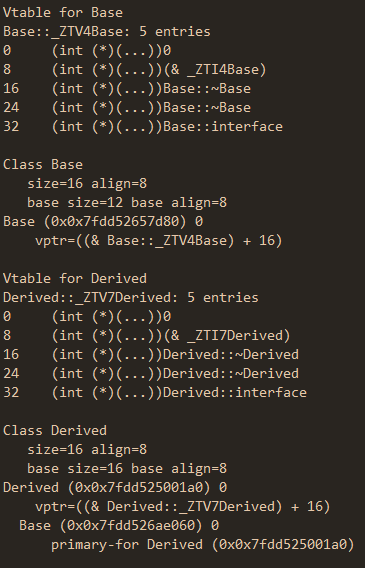
Base 基类的虚函数表中,总共有 5 项,从 offset=0 开始,依次为 top_offset、typeinfo 地址、complete destructor 函数地址、deleting destructor 函数地址、interface 虚函数地址,其中 vptr=((& Base::_ZTV4Base) + 16) 表明虚函数表指针指向的是 complete destructor 函数地址所在的槽位(slot),而不是虚函数表的起始位置。
complete destructor 函数、deleting destructor 函数的作用可以参考:https://www.zhihu.com/question/597138428/answer/3028100403?utm_id=0(补充一点就是,deleting destructor 存储的是基类的析构函数,complete destructor 会去调用 deleting destructor 以正确的析构基类)
Derived 派生类的虚函数表也有 5 项,其中 interface 虚函数覆盖了基类的虚函数,如果 Derived 没有定义 interface() 函数, 那么此函数地址将与基类 interface() 函数地址相同。
使用 g++ test.cpp -o mytest --std=c++11 编译并执行函数:

main() 函数中,long long* vptr = (long long*)(*(long long*)&obj) 语句得到 Derived 类的虚函数表指针,并打印出指针存储的地址(即虚函数表地址),func f = (func)*(vptr+2) 语句将一个函数指针指向 interface() 函数然后调用,结果表明调用的是 Derived 类定义的 interface() 版本。
3.2 多重继承下的虚函数表
如下函数:
#include <stdio.h>
class Base01 {
public:
virtual ~Base01() {}
virtual void interface() {
printf("base01 interface called\n");
}
public:
int b01;
};
class Base02 {
public:
virtual ~Base02() {}
virtual void interface() {
printf("base02 interface called\n");
}
public:
int b02;
};
class Derived : public Base01, public Base02 {
public:
~Derived() {}
void interface() override {
printf("derived interface called\n");
}
public:
int d;
};
int main() {
Derived obj;
return 0;
}
使用 g++ -fdump-lang-class test.cpp 指令导出虚函数表内存结构如下:

Base01 和 Base02 两个基类的虚函数表结构与单一继承相同。在 Derived 派生类中,只有一个虚函数表,但是两个 vptr 指向了表的不同位置,结合虚函数表和对象内存结构图示如下:
4. 动态绑定
4.1 动态绑定的一般概念
我们知道,函数在编译好后会被加载到代码段,并拥有一个可执行的地址,函数调用需要知道函数的地址。与动态绑定对应的就是静态绑定,即在编译阶段就能确定目标函数的地址(注意是虚拟地址空间地址,非物理地址),而动态绑定是指编译阶段无法获知目标函数的地址,只能等到运行阶段才能知道。
说到动态绑定并非一定会联系到多态,如下的一段函数(https://stackoverflow.com/questions/18035293/what-is-early-static-and-late-dynamic-binding-in-c):
using FuncType = int(*)(int,int); // pointer to a function
// taking 2 ints and returning one.
int add(int a, int b) { return a + b; }
int substract(int a, int b) { return a - b; }
int main() {
char op = 0;
std::cin >> op;
FuncType const function = op == '+' ? &add : &substract;
std::cout << function(4, 5) << "\n";
}
function 指向的具体函数,依赖于用户输入,在编译阶段无法确定,只有在运行阶段才能确定,这也是动态绑定。
4.2 动态绑定与多态
与多态联系到一起的时候,如下代码:
#include <stdio.h>
class Base {
public:
virtual ~Base() {}
virtual void interface() {
printf("base interface called\n");
}
public:
int b;
};
class Derived : public Base {
public:
~Derived() {}
void interface() override {
printf("derived interface called\n");
}
public:
int d;
};
void job(Base* obj) {
obj->interface();
}
在 job() 函数中,因为调用的 interface() 函数是虚函数,而编译器无法在编译阶段获知 obj 指向的实际类是哪个,所以无法确定调用 Base::interface() 还是 Derived::interface(),只有在运行阶段,才能根据虚函数表确定 interface() 的实际地址,这便是与多态相关的动态绑定。
注意,obj->interface() 函数实际上会被编译器转换为 (*(obj->vptr)[n])(obj),其中 n 是 interface() 函数在虚函数表中的槽(slot)位编号。所以 Derived::interface() 和 Base::interface() 在各自的虚函数表中槽位编号必须一致。
5. rtti(运行时类型识别)与向上、向下转型
5.1 向上转型(upcast)
即派生类转换为基类,如 Base* obj = new Derived。这种转换为隐式转换,所谓隐式转换,意味着编译器在编译时会适当的安插一些代码,特别是对于多重继承:
// 多重继承: class Derived: public Base01, public Base02 {}
对于:
Base02* obj = new Derived;
会被隐式转换:
Base02* obj = (Base02*)((char*)(new Derived) + sizeof(Base01));
对于单一继承,或者多重继承最左边的基类,因为对象地址是对齐的,则不需要加上偏移。
可以看到,向上转型必须知道实际类的类型,必须知道类的继承关系,如果不知道,那么偏移量将无法确定,如下函数:
#include <stdio.h>
class Base01 {
public:
int data = 100;
};
class Base02 {
public:
int data = 101;
};
class Derived : public Base01, public Base02 {
public:
int data = 102;
};
int main() {
void* tmp = new Derived;
// Derived* tmp = new Derived;
Base02* obj = (Base02*)(tmp);
printf("data value: %d\n", obj->data);
return 0;
}
执行 g++ test.cpp -o mytest 并运行:

可以看到,由于 tmp 是 void* 类型,向上转型的时候结果将是未定义的。
另外注意,向上转型需要编译器知道实际对象的类型,与 rtti 无关。
5.2 向下转型(downcast)
即基类转换为派生类,如 Derived* obj = (Derived)base,或 Derived obj = dynamic_cast<Derived*>(base)。支持此种转换需要知道对象的实际类型,以及 subobject 在派生类中的偏移。
与向上转型不同,编译器在编译期间实际上无法知道对象的实际类型,无法在编译期间安插转型代码,只能在运行阶段才能完成转型。
5.3 rtti(运行时类型识别)
前面在介绍虚函数表的时候,虚函数指针之上还有两个槽(slot):
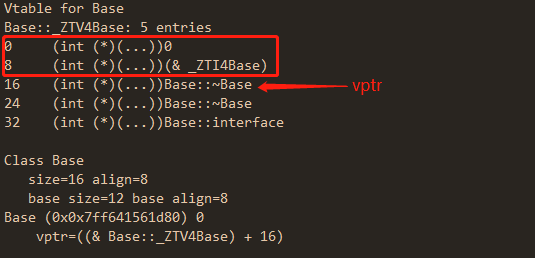
- 第一个偏移量为 0 的槽,被称为 top_offset,是一个数值
- 第二个偏移量为 8 的槽,被称为 typeinfo,是一个指向 class typeinfo 类的指针
需要注意的是,只有基类拥有虚函数才会有虚函数表,才能存储 rtti 信息。如果基类不含有虚函数,那么 dynamic_cast 在编译阶段就会报错。
5.3.1 top_offset
在多重继承中,实现向下转型时,必须知道基类的 subobject 在对象中的偏移,以实现:
Derived* obj = (Derived*)base
向下转型,使得 obj 指针指向 Derived 对象的起始位置(offset可正可负):
Derived* obj = (Derived*)((char*)base + offset)
不同于向上转型,offset 无法在编译时获得(不知道对象的实际类型),为此,虚函数表中的 top_offset 专门用来作为转型所需的 offset。例如多重继承 class Derived: public Base01, public Base02 {},使用 g++ -fdump-lang-class test.cpp 指令查看派生类的虚函数表结构:
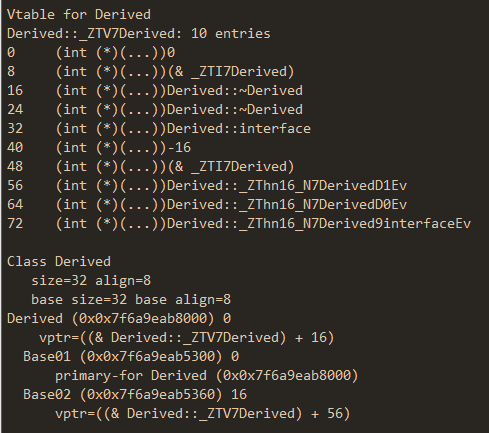
虚函数表偏移量为 0 的 top_offset 值为 0,因为 Base01 的 subobject 本身与 Derived 类对象起始地址对齐;虚函数表偏移量为 40 的 top_offset 值为 -16,因此从 Base02 向下转型为 Derived 时,需要减去 16 字节的地址才能回到 Derived 对象的起始地址。
5.3.2 typeinfo
向下转型也需要安全性保证,即对象实际类型需要与等式左边的类类型相同,不然不管不顾直接加上 top_offset,将会导致程序错误。
为了实现运行时对象类型识别,c++ 引入了 typeinfo 类,并为每个类示例化了一个 typeinfo 类对象(实际上 typeinfo 类是一个基类),将对象地址放置在虚函数表中,向下转型时,根据虚函数表找到 typeinfo 对象,即找到了对象的实际类型。
注意,在多重继承中,派生类的虚函数表有多个 typeinfo 对象:
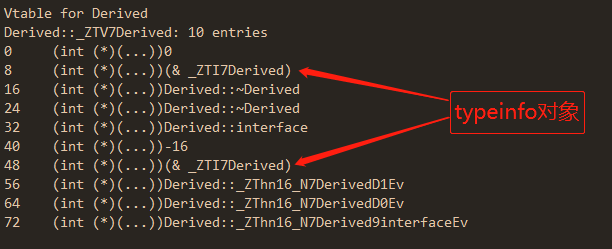
实际上,这两个槽指向的是同一个 typeinfo 对象,这样同一个类的多个虚表指针也都能得到相同的 typeinfo 对象。
6. 虚析构函数
释放一个对象有两个任务需要完成:
- 正确的调用析构函数
- free 掉申请的内存
不考虑虚函数,对于如下代码:
多重继承(非虚):
class Derived: public Base01, public Base02 {}
对象一:
Derived* obj01 = new Derived;
delete obj01;
对象二:
Base01* obj02 = new Derived;
delete obj02;
对象三:
Base02* obj03 = new Derived;
delete obj03;
- 在 Derived 类的析构函数中,编译器会在用户代码的最后插入对两个基类对象析构函数的调用
- delete obj01 时,会调用 Derived::destruct(),然后依次调用基类 subobject 的析构函数;且因为 obj01 的地址是 new Derived 返回的起始地址,free 内存也能成功。
- delete obj02 时,调用的是 Base01::destruct(),无法调用到 Derived 和 Base02 的析构函数;但是因为 obj02 所属的 subobject 是与 Derived 对象起始地址对齐的,free 内存能够成功。
- delete obj03 时,调用的是 Base02::destruct(),无法调用到 Derived 和 Base01 的析构函数;且 obj03 所属的 subobject 与 Derived 对象起始地址不对齐,差了 sizeof(Base01) 的 offset,free 内存将失败(直接dump)。
如果两个基类定义了虚函数,那么 delete obj02 和 delete obj03 时,根据虚函数表,调用的是 Derived::destruct(),然后依次调用基类 subobject 的析构函数;同时调用析构函数时能够根据 rtti 信息能够向下转型(downcast)为 Derived 对象 正确得到 this 指针,free 内存才能成功。



【推荐】国内首个AI IDE,深度理解中文开发场景,立即下载体验Trae
【推荐】编程新体验,更懂你的AI,立即体验豆包MarsCode编程助手
【推荐】抖音旗下AI助手豆包,你的智能百科全书,全免费不限次数
【推荐】轻量又高性能的 SSH 工具 IShell:AI 加持,快人一步
· 地球OL攻略 —— 某应届生求职总结
· 周边上新:园子的第一款马克杯温暖上架
· Open-Sora 2.0 重磅开源!
· 提示词工程——AI应用必不可少的技术
· .NET周刊【3月第1期 2025-03-02】